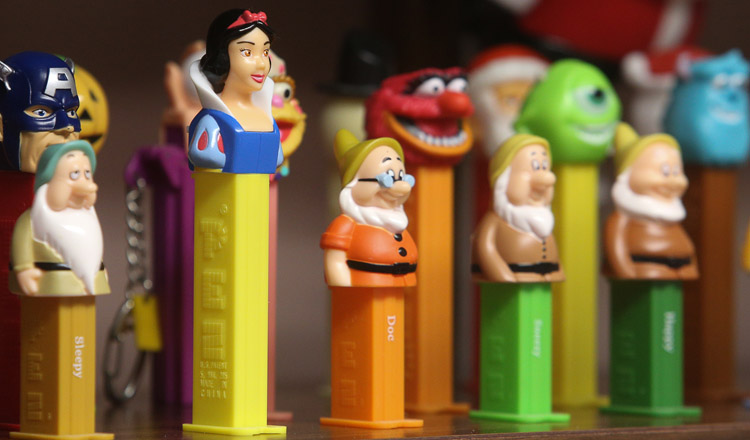Faculty and staff share the stories behind their personal collections
The Nature of Inspiration
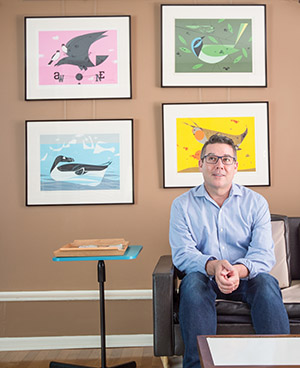
It all started with an image of White Sands. About 10 years ago, Brian Leung, director of the Creative Writing Program, attended an exhibition on graphic art at the Cincinnati Museum of Modern Art. He was captivated by a Ford Times hand-pulled silkscreen print created by Cincinnati-based modern artist Charley Harper (1922–2007), best known for his highly stylized wildlife illustrations. Harper’s 1953 White Sands, New Mexico, was part of a themed series of natural and man-made wonders titled Horseless Carriage Adventures.
The four carriages appear minuscule on the horizon, surrounded by the vast alabaster landscape. “I loved this image as soon as I saw it,” says Leung. “I thought, ‘there has to be a poster or something of this.’” He started searching for
Harper’s work and discovered an online auction for an original Ford Times serigraph. “White Sands was my first purchase,” says Leung. “And then I kind of went crazy.”
‘White Sands’ was my first purchase — and then I kind
of went crazy.
So crazy that he’s run out of wall space to display them all. Harper’s work is found on every floor and every wall of the 2,400 square-foot mid-century modern house Leung shares with his husband, whom he credits with organizing the collection. “He’s the one with aesthetics,” says Leung. “He rotates our art and changes out the displays.”
Leung estimates he owns around 60 Harper serigraphs. One of his most prized acquisitions is Little Boy Blue. It was pulled as a sample for a children’s book that was never published and is the only one in existence. He also has plenty of Harper’s hallmark geometric animals. A tiger’s head, a lobster, insects, and dozens of birds are composed of bright colors, simple geometrics, and bold lines. Harper referred to his flat, whimsical signature style as “minimal realism,” saying, “I don’t try to put everything in, I try to leave everything out.” It’s an approach to art that resonates with Leung.
“When I write, I write at the sentence level — beautiful, precise sentences — but don’t look at my sock drawer. I am messy.”
Candy Queen
At first it was a joke. Kelly Murray, a nurse practitioner at Purdue University Student Health Center (PUSH), received her first plastic Pez dispenser — a Halloween pumpkin — through a yearlong Secret Santa gift exchange.

“I just put them on a shelf. Then other people started buying them for me, and I got more every holiday.” Coworkers are mostly responsible for building her collection, although students have started contributing, too. Murray estimates she’s amassed more than 60 of the colorful candy wands over the past 15 years. “I don’t even like Pez.”
Magnetic Memories
Memorable vacations are top of mind for Ronald J. Stephens, professor of African American studies, who maintains a travelogue of his adventures through the magnet collection on his fridge. A 2006 trip to Garden of the Gods in Denver, Colorado, yielded the start of his collection.
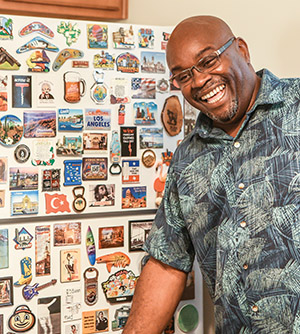
“I had the idea that I was going to collect a magnet from every place I go,” says Stephens. The majority of the collection has been sourced from domestic travel. A few were gifts, some of which represent bucket list trips. “A friend of mine was going to South Africa,” says Stephens. “The first thing I did was say, ‘Do me a favor? Please bring me back a magnet.’”
Stephens specializes in 20th-century African American history and culture, and many of his magnets reflect that interest. “I was in Detroit at Hitsville USA, home of Motown, and I wanted something specifically to reflect Detroit,” says Stephens. “I found a magnet with a picture of the actual studio of Hitsville where the Temptations got started.”
There’s one from the National Underground Railroad Freedom Center in Cincinnati, Ohio, and another features a recipe for Jambalaya from a trip to New Orleans, Louisiana, where Stephens was fascinated by the above-ground cemeteries and jazz funerals with bands playing in the funeral procession.
It’s an eclectic collection, featuring magnets that express his political views and his sense of humor. While searching for a souvenir in Branson, Missouri, Stephens happened upon a magnet that was irresistible: “‘Wine makes my clothes fall off!’ I saw that one and just laughed my head off.”
And what does Stephens hope a casual observer would glean from his hodgepodge of magnets? “They would see my fridge and think I am a pretty cool guy. I travel a lot.”
Classic Tale
Judy Nixon purchased her first copy of A Visit From St. Nicholas in 1976 for $5.95 for a grad school project on children’s literature. At the time, the HSSE education librarian had no idea she would eventually acquire around 500 versions of Clement C. Moore’s classic holiday poem, more commonly known as “’Twas the Night Before Christmas.”
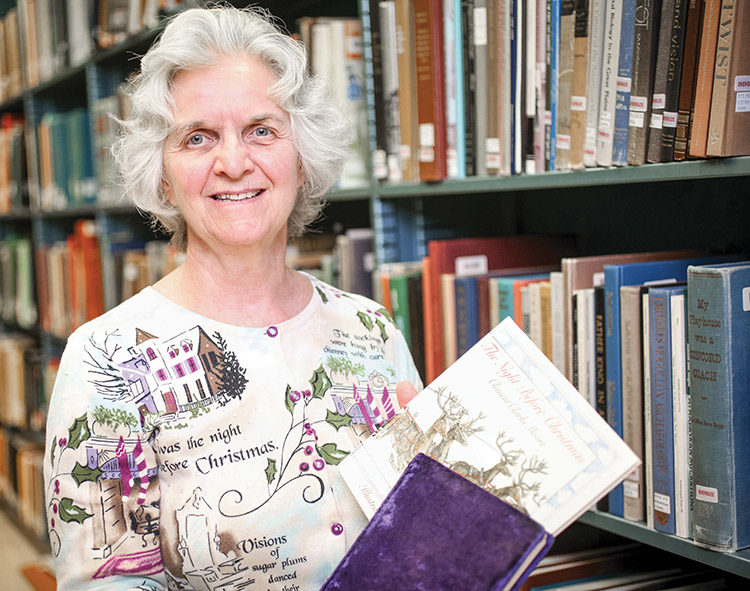
Nixon sought out certain collector’s editions, such as a book designed by Bruce Rodgers in the 1920s with hand-sewn binding and the original title. She has three versions illustrated by Thomas Nast, an editorial cartoonist during the Civil War who first depicted the elephant and donkey icons for the political parties. Nast’s illustrations in Santa and his Works popularized the image of a portly, jolly elfin man in a red fur suit. “Nast’s depictions have done more to influence modern images of Santa Claus than any other illustrator,” says Nixon. She isn’t convinced Nast was going for red, however. Earlier versions of Nast’s Claus were clad in brown. “I think he might have been mixing red and green, trying to get brown,” she says.
Her collection includes a Garfield edition drawn by Indiana cartoonist Jim Davis (1988); Denslow’s Night Before Christmas (1902) by WW Denslow who illustrated The Wonderful World of Oz, a contemporary pop-up book with silhouetted scenes (2007); and a version featuring the bold, colorful illustrations of Australian artist Robert Ingpen. “That one’s a favorite,” says Nixon.
Each year on the night before Christmas, Nixon selects one of the books to read aloud. Some years, her home is filled with family, her grandchildren gathered at her feet. Other years, she reads to an audience of one — her husband. “I love reading the poem aloud on Christmas Eve,” she says. “It’s tradition.”
All Decked Out
Brent Jesiek’s fascination with boarding began in grade school in Holland, Michigan. Street skating was at peak popularity among youth in the 1980s. “My dad was a carpenter by trade, so we would raid his wood supply to build ramps,” says the associate professor of engineering education. “Dumpsters were a good source of wood once we were older and had cars.” Jesiek’s best friend lived across the street, and the two would create a makeshift skate park in the road and then throw it back in the yard at the end of the day.
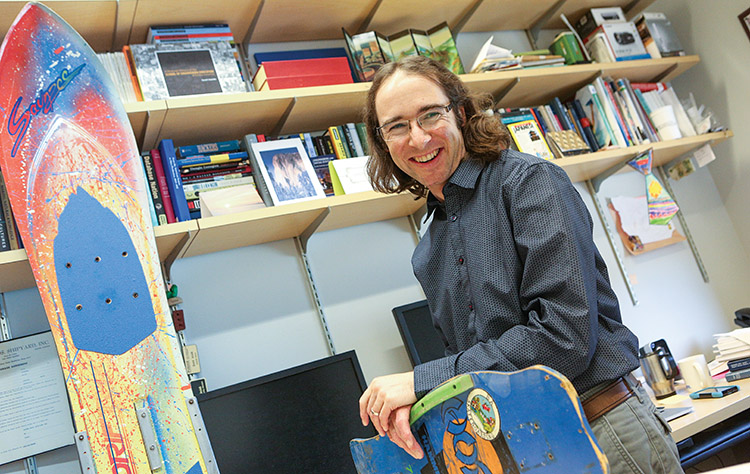
In all, he has four skateboards, three or four snowboards, and “a lot more” surfboards. One of his first skateboards, a small, blue hammerhead, is covered in stickers. “Stickers are about skate culture,” he says. “That extended over into snowboarding, too. It’s about decorating and customizing your gear and showing off your favorite brands. There’s a humor aspect to it, in terms of who can be the most creative with it.”
Similar to skateboarding, snowboarding grew in popularity partly because of its affiliation with an alternative punk culture. “When snowboards were first commercially made, they couldn’t figure out how to make them turn on hard packed snow, so metal edges were bolted on. Modern snowboards have complete metal edges all around, and that’s how you turn,” says Jesiek. “That’s part of what interests me as a historian of engineering and technology. What fascinates me is how the technology has evolved over time.”
Although the sport of snowboarding was initially viewed as countercultural to skiing, Jesiek has noticed that these days, the inverse seems to be true. His own son has taken up skiing and hasn’t shown much interested in boarding, either snow or street. Jesiek himself isn’t as active a snowboarder as he was in college. He grew up bodyboarding on Lake Michigan as a teen and eventually graduated to surfboards. He started surfing on his first stand-up paddleboard about two years ago. “Surfing is a lot gentler on the body,” he says. “I disconnected my shoulder snowboarding two years ago. That was my 40-something reality check.”
Still, he hasn’t left the sport behind entirely. “My good friend from down the road who I grew up snowboarding with, he has a house in Colorado now,” Jesiek says. “I went for a visit and prior to my arrival, he built a quarter pipe in his yard. So we’re still doing it.”
Love of Bloom
A waddle of penguins fills Stephen Hoffmann’s home. The new assistant head of the chemistry department remembers his first Opus, a gift from a high school friend. The stuffed animal with the red bow tie is now dingy with age. Hoffman’s obsession with Berke Breathed’s Bloom County comic strip, which ran from 1980 to 1989, was well-known among his friends.
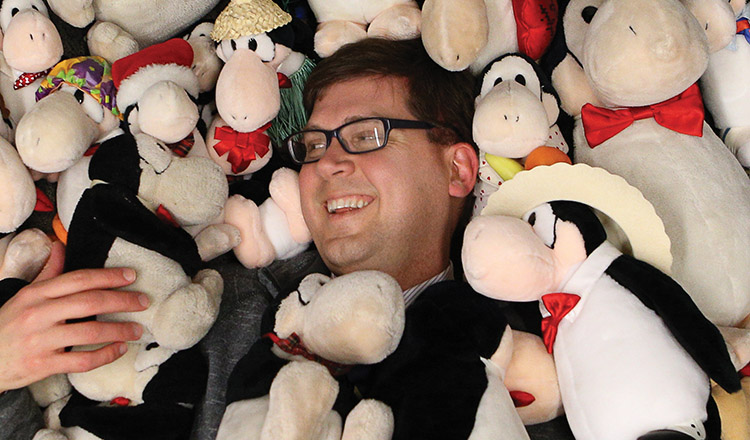
“I identified with Opus,” says Hoffman of the eternally optimistic penguin character stuck in Iowa. “He’s a perennial loser. But he makes the funny jokes.” Hoffman appreciated the comic’s biting satire, much of it political in nature. “Opus ran for vice president twice on the Meadow Party ticket.”
By high school graduation, Hoffman had acquired a few more “Opera” here and there. It was a collection he inherited from his brother-in-law that tipped the scales. Hoffman estimates he now has 30 or 40 lying around the house. “We have a spot where they live, upstairs in a hallway under a slanted roof,” he says. “They start out sitting in rows, but the kids pick them up and move them around. If we haven’t cleaned the house in a while, there may be a penguin in every room.”
Hoffman’s wife gave him a penguin holding a heart that read “Penguin Lust” shortly after the couple started dating. “That made me realize they were available on eBay, and I had a chance to get the full collection,” he says. “Some of the rarer ones can sell for up to $100.”
Although all are Opus, Hoffman has given many distinct names. The one he gave to his wife is Lefty. Stanley is the largest. Maury (after Povich) wears a shower cap. Aldo, named for wildlife ecologist Aldo Leopold, dons a safari hat. “Sometimes I forget their names, and I have to name them again,” he says. “I don’t keep a
log anywhere.”
Hoffman gave each of his children a vintage Opus at birth. His son’s stuffed animal is called Pepe, short for Personal Penguin. “Pepe goes to daycare every day,” says Hoffman. “He’s getting really threadbare. He gets lots and lots of love.”
Chock-full
Growing up in post housing left a lasting impression on James Jenkins, associate professor of construction management technology. With a father in the military, the family moved frequently. “We weren’t allowed to hang anything on the walls, even tape,” says Jenkins. “I lived with blank walls during my formative years. It drove me crazy.”
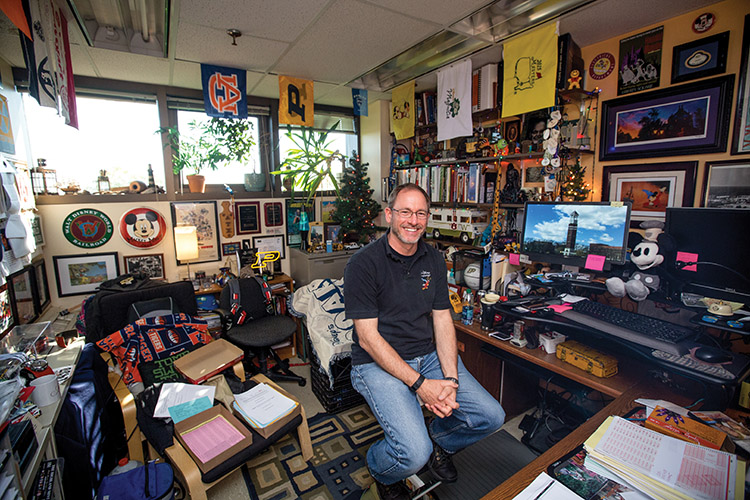
Colleagues find the amount of stuff crammed into his 80-square-foot office overwhelming and give him a fair amount of ribbing over it. For Jenkins, covering every square inch of available space is comforting. “Some faculty have blank walls and I don’t like going into those offices,” he says. He’s always been an eclectic collector, much to the chagrin of his wife.
“I’ve been selling stuff on eBay to make my wife happy.I have way too much junk.”
Still Adding
As a young boy, Troy Janes was fascinated by calculators. Not so much as a mathematical interest, he mostly liked pressing the buttons and spelling out words. Fast forward to about seven or eight years ago, maybe due to “a midlife crisis or something,” the clinical associate professor in the Krannert School of Management became nostalgic for the devices he played with as a kid. “I remembered my interest in calculators and thought starting a collection would be cool,” says Janes. “I began seeking out the calculators I remembered using in my youth, and I just got carried away.”
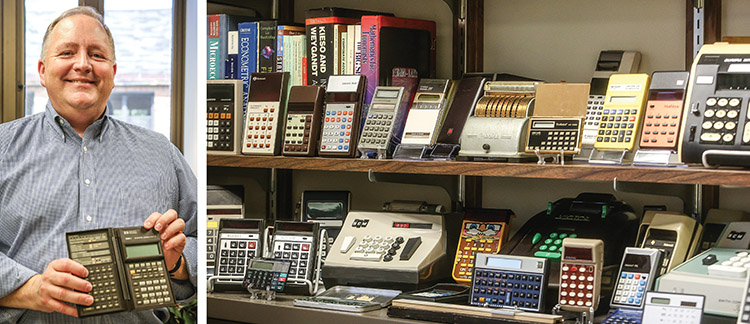
The collection started with pocket calculators, but quickly grew with other varieties. His acquisitions consist mostly of electronic calculators and electric adding machines, but he also has some mechanical adding machines, a few abacuses, and one slide rule.
Many of the calculators bridge connections to his past. “My grandfather had a Commodore adding machine that I would always play with when I visited him growing up,” he says.
Janes wanted to get his hands on one and tracked it down. He also searched for machines his parents and grandmother owned. Janes estimates he now has about 140 items in his collection. He does try to buy only machines that still function, but he doesn’t use most of them. “I do pull out the adding machines or larger calculators on occasion to assist in grading accounting exams,” he says.
Although quite a few are on display in his office, Janes keeps many more at home in boxes. In his accounting classes, he presents a “calculator of the week” to his students, sharing a history of the personal calculating device — from the abacus to graphing calculators.
The HP 19BII is a model Janes coveted while he was in college but couldn’t afford to buy it. Now that he’s finally got one, he uses it all the time. One of his favorites is the Novus 650 “Mathbox,” introduced in the mid-’70s. “Novus wanted to create a cheap calculator to appeal to more consumers,” he says. The Mathbox cost $10 instead of the typical $20–$30. To save on costs, the device has no equal button and uses reverse Polish notation. It only has a six-digit display compared to typical 8-digit and has a fixed decimal. “It’s regarded as the worst calculator ever made,” he says.
Janes describes the HP 12C programmable financial calculator as a “hipster calculator for finance and real estate professionals.” It was vaunted as indestructible. “Supposedly, a zookeeper had one, and a rhino swallowed it,” he says. “When it came out the other end, it still worked.”
Passion for Action
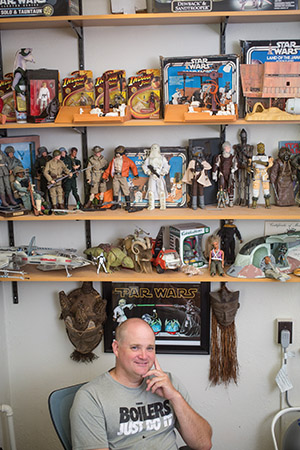
The shelves above Reuben Goforth’s desk are packed with vintage action figures, primarily of the Star Wars and GI Joe variety. The associate professor of aquatic ecosystems has been avidly collecting toys from his childhood for years. “For me, part of it is that I am just a big kid anyway,” he says. “So it helps to hang on to my past.”
The toys often serve as a conversation piece for students visiting Goforth’s office. “Sometimes, students see professors as unapproachable people. Having an office that reflects my interest and personality puts students at ease,” he says. “These help students see me as a regular person instead of an intimidating authority figure.”
Goforth was 7 years old when Star Wars first came out. “I was the perfect age,” he says. “Ever since then, I have been strongly affected by Star Wars.” He has a vintage Land of the Jawas play set. A bevy of bounty hunters covers a corner of his desk. “I have always liked the bounty hunters from Empire Strikes Back,” he says. “I am particularly taken with Bobo Fett.” His Star Wars collection used to be much larger, but he’s pared it down over the years.
Among his most treasured toys are the GI Joes that belonged to a friend who was a biologist for the state of Indiana and passed away a few years ago from ALS. Nestled among the soldiers is Goforth’s own certificate of membership to the GI Joe adventure team.
A few additional toys are interspersed among the action figures, such as a Tonka Truck like the one he received as a child when he learned how to tie his shoes. His most prized piece is an action figure still in the original packaging from 1978. It’s the same as one that Goforth’s mother brought home for him from a business trip.
“I would say the toys that are the most important to me have some kind of personal relevance like that,” says Goforth. “I enjoy surrounding myself with things that make me feel like I am at home in the place that I work.”
Kat Braz (LA’01) is editor of Purdue Alumnus magazine.

